While 1.2G video is working very well for flying around obstacles, it also has own limitations. 2.4G video is somewhere in middle – small VTX, smaller antennas and good enough penetration, but unsuitable for flying in city (WiFi everywhere) and in meetings (2.4G RC adds a lot of noise even on 2370/2510 channels).
So, i moved back to 5.8G with some of my copters. Did simple RSSI-based diversity, added RX5808 modules to my HMD… Works good enough for everyday flying, but i noticed, that my friend can fly further using FR632 RX. LOS Range is acceptable for both, but he was flying further over obstacles and in buildings.
Ordered similar FR632 and decided to test, why it is better. Tested if it’s working, disassembled, took pictures of all components. Also purchased several RX5808 modules to compare. Built “OLED-RX5808-Pro” diversity (using wires – all high-freq parts are in module, should not matter much in theory) for comparison…
So, what we got:
I had mini copter with VTX and antenna, used the same hardware on all tests. Had the same route and approx the same speed for each test, was holding copter at the same place, ~6cm from antenna. On receiving end – RX antennas are fixed in one position, only RX’es are exchanged. I guess, environment variations between tests are very similar. Also, 5.8G is still almost unused in my house, noise floor is still very low (i checked with RF explorer); someone is using one AP on opposite end of house, should not matter much, but i moved further away from that AP and used 5685MHz for all tests.
Video consists from several parts:
- “Stock” hardware comparison, first scene. I was using FR632 (lots of photos online) and few different RX’es:
- RX5832 – uses different module compared to others. Sensitivity “on paper” is lower, compared to RX5808 (-85dB vs -90dB), but reality is different story… Channel order is a bit weird (boscam channels are “A” band, etc), but everything else is pretty much simple (band – long press, channel change – short press).
I replaced SMA-RP connector with SMA and slightly shortened pins, prob. will solder directly on module if i decide to use this module in my HMD.

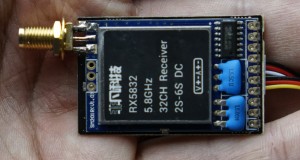
- My HMD, using RX5808 modules, with SMA soldered directly to module (with shortened pins – only ~1.5mm remaining, to minimize reflections and loss. No picture from inside (glued in), but from outside it looks like (5.8G is in top-right side, 2.4G/1.2G modules are on left):
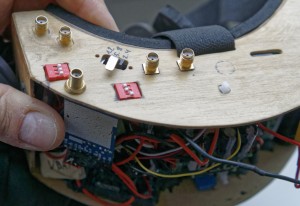
- RX5808-Pro OLED diversity (picture is with all mods – additional grounding near SMA, etc):
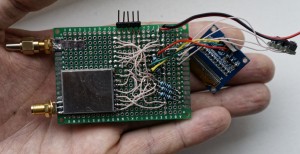
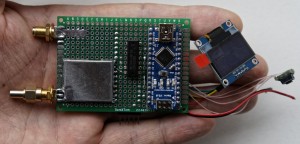
So, in first part is just comparison between different RX’es – 5808 mounted on PCB, 5808 with “direct SMA mount”, 5880 inside FR632. IMO FR632 clearly holds victory…
- RX5832 – uses different module compared to others. Sensitivity “on paper” is lower, compared to RX5808 (-85dB vs -90dB), but reality is different story… Channel order is a bit weird (boscam channels are “A” band, etc), but everything else is pretty much simple (band – long press, channel change – short press).
- Diversity test – used helical + skew-planar antennas. Helical was pointing approx into required direction (i probably missed a bit, because i remember that i can have good enough video with helical pointed into required direction – but anyway, that was more “diversity test” and antenna direction remained the same in all tests). Again, FR632 looks not bad, but i do not know any RSSI-based diversity controller which would work really well.
- Disassembled FR632, unsoldered one module (not easy task to do – LCD is close, you can’t use hot air on bottom module pins, so need to work with soldering iron). Close-up RX5808 and RX5880:
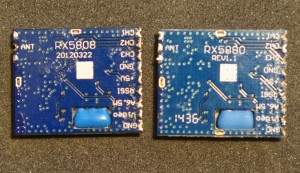

Then soldered RX5808 module (with SPI mod) on FR632 – so i can test both modules on the same PCB.
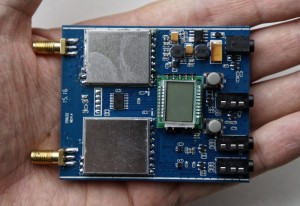
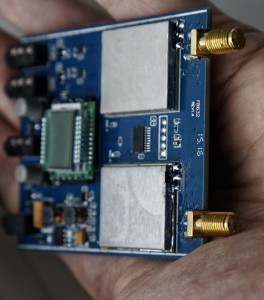
(one module has removable cover – RX5880, another is solid-soldered – RX5808) - Soldered RX5880 module from FR632 on that PRO diversity and tested again. Removed all possibly-resonating tracks on PCB (on RF side), added additional ground, shorted pins – i guess should be good enough to minimize reflections and not radiate stuff to outside.
….took maybe 4 evenings to finish all tests ;-)
Conclusions:
- RX5880 and RX5808 are different. RX5880 is slightly better, compared to RX5808 (in all tests). SPI control and pinouts are the same so if you plan to do new RX for your needs – try to find RX5880
- Higher sensitivity on FR632 is probably due to two components – better modules (RX5880) and good PCB design (only guess). The same RX5808 module which was performing very bad on D-Pro – was working well (ok, acceptable) on FR632
I do not like FR632 form factor and design (requires to press button to power on, diversity triggering isn’t configurable), so i will try to clone PCB frontend and re-test (FR632 uses Nuvoton N79E814 as SPI controller and probably diversity controller, no idea if firmware can be modified). FR632 uses Coplanar Waveguide with Ground (at least looks like – see fig. 39), should be easy to calculate required widths.
Also… 2.4VTX with the same rated power output and omnidirectional antennas = fully flyable (with some snow) image 1.5 story below. 5.8G just plain sucks when you want to fly over buildings…
UPDATE 2016.02: uploaded video again (G deleted my acc) and tested RD40 – its somewhere in middle between FR632 and RX5880. Nothing exceptional.
Šis 5.8G analoginių imtuvų palyginimas yra neįtikėtinai naudingas FPV entuziastams! PTS Terbaik